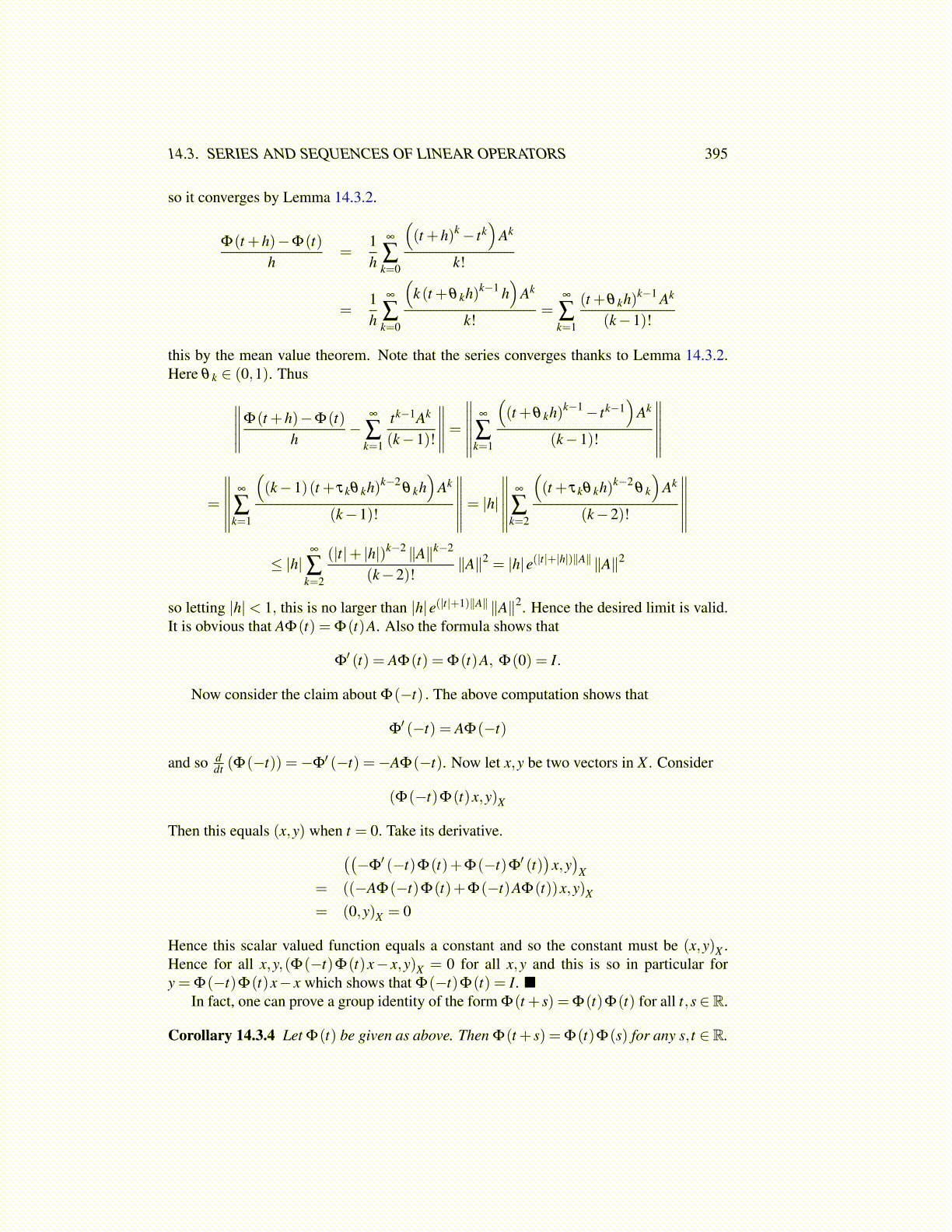
14.3. SERIES AND SEQUENCES OF LINEAR OPERATORS 395
so it converges by Lemma 14.3.2.
Φ(t +h)−Φ(t)h
=1h
∞
∑k=0
((t +h)k− tk
)Ak
k!
=1h
∞
∑k=0
(k (t +θ kh)k−1 h
)Ak
k!=
∞
∑k=1
(t +θ kh)k−1 Ak
(k−1)!
this by the mean value theorem. Note that the series converges thanks to Lemma 14.3.2.Here θ k ∈ (0,1). Thus∥∥∥∥∥Φ(t +h)−Φ(t)
h−
∞
∑k=1
tk−1Ak
(k−1)!
∥∥∥∥∥=∥∥∥∥∥∥
∞
∑k=1
((t +θ kh)k−1− tk−1
)Ak
(k−1)!
∥∥∥∥∥∥=
∥∥∥∥∥∥∞
∑k=1
((k−1)(t + τkθ kh)k−2
θ kh)
Ak
(k−1)!
∥∥∥∥∥∥= |h|∥∥∥∥∥∥
∞
∑k=2
((t + τkθ kh)k−2
θ k
)Ak
(k−2)!
∥∥∥∥∥∥≤ |h|
∞
∑k=2
(|t|+ |h|)k−2 ∥A∥k−2
(k−2)!∥A∥2 = |h|e(|t|+|h|)∥A∥ ∥A∥2
so letting |h|< 1, this is no larger than |h|e(|t|+1)∥A∥ ∥A∥2. Hence the desired limit is valid.It is obvious that AΦ(t) = Φ(t)A. Also the formula shows that
Φ′ (t) = AΦ(t) = Φ(t)A, Φ(0) = I.
Now consider the claim about Φ(−t) . The above computation shows that
Φ′ (−t) = AΦ(−t)
and so ddt (Φ(−t)) =−Φ′ (−t) =−AΦ(−t). Now let x,y be two vectors in X . Consider
(Φ(−t)Φ(t)x,y)X
Then this equals (x,y) when t = 0. Take its derivative.((−Φ
′ (−t)Φ(t)+Φ(−t)Φ′ (t))
x,y)
X
= ((−AΦ(−t)Φ(t)+Φ(−t)AΦ(t))x,y)X
= (0,y)X = 0
Hence this scalar valued function equals a constant and so the constant must be (x,y)X .Hence for all x,y,(Φ(−t)Φ(t)x− x,y)X = 0 for all x,y and this is so in particular fory = Φ(−t)Φ(t)x− x which shows that Φ(−t)Φ(t) = I. ■
In fact, one can prove a group identity of the form Φ(t + s) = Φ(t)Φ(t) for all t,s ∈R.
Corollary 14.3.4 Let Φ(t) be given as above. Then Φ(t + s) = Φ(t)Φ(s) for any s, t ∈R.